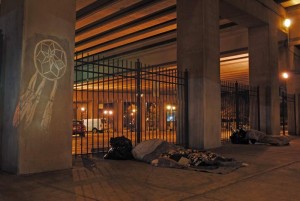The article “Tapestry Of Space: Domestic Architecture And Underground Communities In Margaret Morton’s Photography Of A Forgotten New York” by Irina Nersessova, discusses the impact of architecture on a person’s psyche and behavior.
Margaret Morton compares building a home to someone with a splintered personality attempting to connect the pieces together to build a whole identity for themselves. She does this to establish a relationship between a person’s identity and their home. She also addresses the fragility of someone building a home because no one is sure whether it is permanent or not. The homeless are defined as not having a stable home, and are the best way to see a relationship between “space and the splintered identity.”
Mass media is used a tool to steer the behavior of society into thinking that they need various material items. This, along with capitalism, are allowing the status quo to continue on unabated. Morton uses photography to expose the not so glamorous side of a society focused on amassing material items, and maintaining an image. She was attempting to show that this comes at the cost of many people suffering. All this was done to show how architecture can influence one’s behavior. The role of the urban photographer is to show the real images of what it is like to be homeless. They are there to tear apart any false images society may have, but they are not attempting to sell the idea of homelessness to anyone.
Urban photographers and tourists are both on a journey to explore the city. The difference is that, the tourist is there to see the nice side of things while the photographer is attempting to “understand” the space they are exploring. The underground serves as a sort of physical and mental refuge for the people that go down there. They go to escape the pressures and dangers of living above ground. The psycho-geography of the tunnel makes it more than a place for homeless people to survive. It allows for the tunnel to contain its own society.
The word homeless is sometimes equated to being a criminal. They became undesirables. The homeless are hidden from the eyes of the public to help make the city more attractive to people such as tourists. It is all done in the interest of business. Society had grown to a point where they deemed their self-worth upon how much wealth or commodities they were in possession of. This, in turn, blinds society to the woes of the less fortunate. Since the homeless are not as distracted by material items, they are more aware of the fragility of where they live. The homeless may be seen as “lazy,” but in reality they are hardworking because of their need to establish a dwelling for themselves.
To conclude, the reader is made to see that the homeless are more connected to the spaces they live in than people who have more material wealth. It is established that the homeless are not actually without a home, it is the fact that their homes are not as stable. Society sees the homeless as the outcasts, but they fail to realize that the homeless are closer to them than they thought.
Bibliography
NERSESSOVA, IRINA. “Tapestry Of Space: Domestic Architecture And Underground Communities In Margaret Morton’s Photography Of A Forgotten New York.” Disclosure 23 (2014): 26. Advanced Placement Source. Web. 20 Nov. 2015.
Leave a Reply